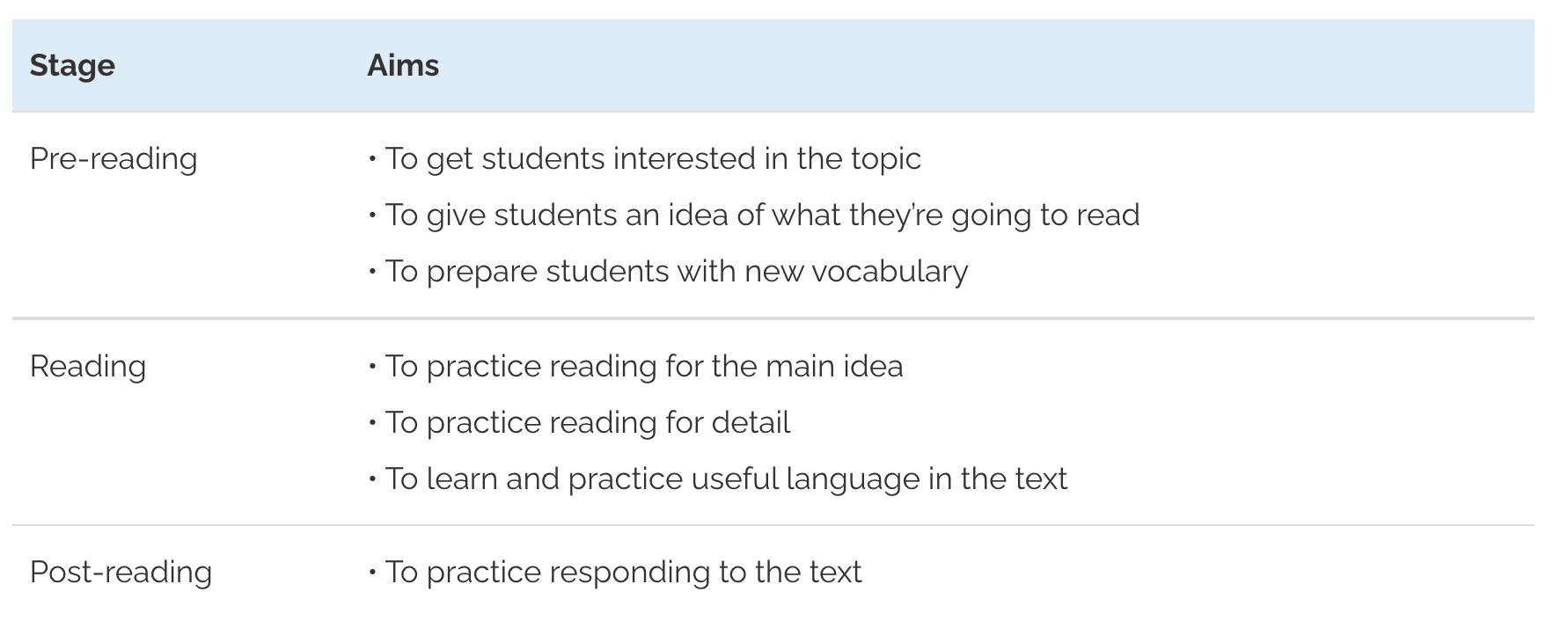Designing a reading lesson in five minutes
Oct 22, 2021
By James Jenkin
Students should read more. Reading has a significant impact on learners’ English in general: it seems to raise proficiency in other skills, such as writing and speaking (Waring, 2006).
Studies such as Ro (2016) report that extensive reading has a positive effect on students’ reading motivation.
Reading lessons are also an opportunity to give students interesting and varied input.
However, designing a reading lesson seems tedious and time-consuming. Don’t we have to write lots of comprehension questions?
I suggest you can design a lesson that’s both useful and engaging in only five minutes. (You can spend some of the time you save looking for interesting texts.)
A Reading Lesson Framework
Before we start, you may remember lesson staging from your TESOL training that looks something like this:

It’s the approach taken in many course books, and it’s a useful starting point.
The Reading Stage
Let’s start with the reading stage, because you’ll only know how to prepare students in the pre-reading stage once this is finalized.
Imagine your students are studying business, so you’ve found a text they’ll enjoy reading and have opinions on – business DOs and DON’Ts in three countries.
1. Reading for the main idea
This activity is designed to help students read quickly for the main idea, a skill they use without thinking in their first language, but may find hard in English. Use a time limit, and be serious about it. Give the text out face down, have students turn it over when you say ‘Go!’, and after thirty seconds say ‘Stop!’.
Use one of these two types of questions:
- ‘What are the …?’ (‘What are the three countries?’)
- ‘Is it about X or Y?’ (‘Is it about good behavior, bad behavior, or both?’)
2. Reading for detail
If information in the text can be grouped, get students to copy a table from the board like this:

Students read and take notes.
You can maximize interaction by giving out one copy of the text between two, and have students make notes together. Also consider a ‘jigsaw reading’, where different students read about one country only, then share the information they found.
For other types of texts, look for a feature. For example, newspaper articles often contain a lot of names and numbers. Have students underline all the names and ask ‘What did they do?’, or all the numbers and ask ‘What do the numbers mean?’
3. Teach useful language in the text
As a rule, look at the verbs. In this case, they’re mainly present simple for habits: ‘Japanese exchange business cards’.
Check whether students understand the meaning: ‘Does this happen one time, or every time?’ Then ask them to name the tense.
Now let students practice: ‘Interview your partner and write down three DOs and three DON’Ts in their country’.
The Pre-reading Stage
1. Getting students interested
You need a visual. It’s easy if there’s Internet in the classroom. Just show a picture (e.g. businesspeople bowing) and have students discuss a relevant question in groups: ‘What do you know about business DOs and DON’Ts in different countries?’
2. Introduce the text
Next, show (but don’t give out) the text, and announce it with some fanfare: ‘You’re going to read about how to behave in different countries!’
3. Pre-teach vocabulary
Decide on five words you’re going to pre-teach, to help prepare students for reading. Choose the words students will need to complete the reading tasks – not words that, for example, seem difficult. Elicit rather than explain the words: for example, ask ‘What am I doing?’, and bow.
The Post-reading Stage
This is a chance for students to say what they think about the text. Have students initially discuss in groups so they feel relaxed about speaking their mind.
If students have knowledge of the topic (for example, they’re from one of the three countries described), ask ‘Do you agree?’ If they don’t agree with the text, they’ll be keen to say so.
Ask a challenging question: ‘It’s hard to remember so many rules. Which are the really important ones? Why?’
Conclusion
If you follow this template, it will literally take five minutes to prepare – yet you’ll produce an effective and engaging lesson.
We’d love to hear your ideas for ‘instant’ activities that make planning a lesson easy. Share them in the comments below!
References
Ro, E. (2016). Exploring teachers’ practices and students’ perceptions of the extensive reading approach in EAP reading classes. Journal of English for Academic Purposes. 22(1), 32-41.
Waring, R. (2006). Why Extensive Reading should be an indispensable part of all language programmes. The Language Teacher, 30(7): 44-47.
James Jenkin has worked in the field of TESOL for over twenty years as a teacher, teacher trainer, curriculum designer and academic manager. He is an IELTS examiner and has an MA in Applied Linguistics from Monash University, Australia.
Image source: Shutterstock.com/zhu difeng

